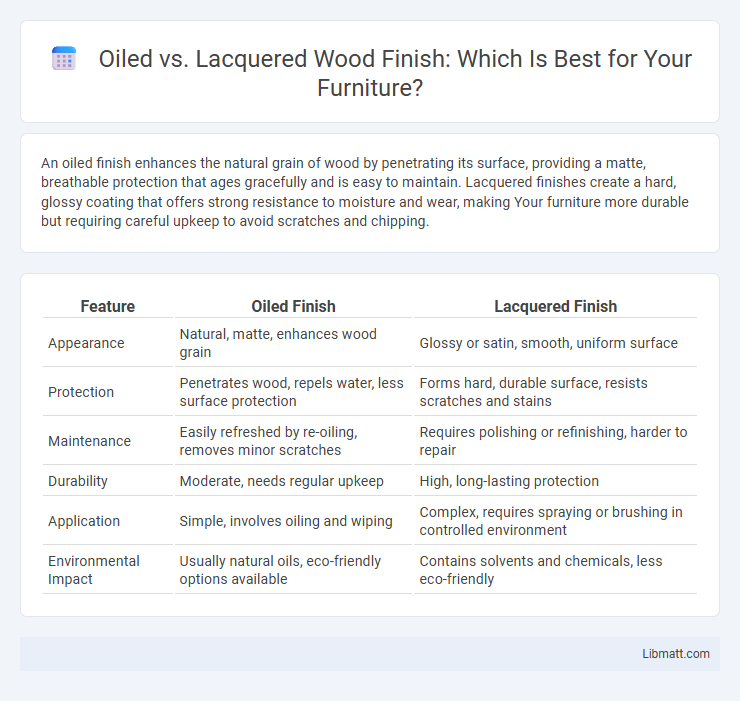An oiled finish enhances the natural grain of wood by penetrating its surface, providing a matte, breathable protection that ages gracefully and is easy to maintain. Lacquered finishes create a hard, glossy coating that offers strong resistance to moisture and wear, making Your furniture more durable but requiring careful upkeep to avoid scratches and chipping.
Table of Comparison
| Feature | Oiled Finish | Lacquered Finish |
|---|---|---|
| Appearance | Natural, matte, enhances wood grain | Glossy or satin, smooth, uniform surface |
| Protection | Penetrates wood, repels water, less surface protection | Forms hard, durable surface, resists scratches and stains |
| Maintenance | Easily refreshed by re-oiling, removes minor scratches | Requires polishing or refinishing, harder to repair |
| Durability | Moderate, needs regular upkeep | High, long-lasting protection |
| Application | Simple, involves oiling and wiping | Complex, requires spraying or brushing in controlled environment |
| Environmental Impact | Usually natural oils, eco-friendly options available | Contains solvents and chemicals, less eco-friendly |
Introduction to Oiled and Lacquered Finishes
Oiled finishes penetrate wood surfaces, enhancing natural grain and providing a matte, textured look while offering moderate protection against moisture and wear. Lacquered finishes form a hard, glossy coating on wood, delivering a durable barrier with high resistance to scratches and stains, ideal for high-traffic areas. Choosing between oiled and lacquered finishes depends on desired aesthetic, maintenance preferences, and functional durability requirements.
Key Differences Between Oiled and Lacquered Finishes
Oiled finishes penetrate wood surfaces, enhancing natural grain and offering a matte, breathable protective layer that requires periodic reapplication, while lacquered finishes form a hard, glossy, and durable coating that seals wood from moisture and wear. Oiled finishes allow for easy spot repairs and maintain a more natural look, whereas lacquered finishes provide a more uniform and high-gloss appearance but are prone to chipping or cracking over time. Choosing between oiled and lacquered depends on the desired aesthetic, maintenance effort, and durability needs for wood furniture or flooring.
Appearance: Natural Look vs Glossy Shine
Oiled finishes enhance wood's natural grain with a matte, subtle sheen that emphasizes texture and warmth, creating an organic, authentic look. Lacquered finishes provide a high-gloss, reflective surface that increases brightness and offers a sleek, polished appearance. The choice between oiled and lacquered surfaces depends on whether a natural, understated aesthetic or a glossy, modern shine is desired.
Durability and Resistance to Wear
Oiled finishes penetrate wood to provide a natural look and moderate protection against wear, requiring periodic reapplication to maintain durability. Lacquered finishes form a hard, protective surface layer that offers superior resistance to scratches, moisture, and daily wear, making them ideal for high-traffic areas. Your choice depends on whether you prioritize ease of maintenance (oiled) or long-lasting surface protection (lacquered).
Maintenance and Upkeep Requirements
Oiled finishes require regular reapplication, typically every 6 to 12 months, to maintain their protective properties and natural appearance, making them ideal for those who prefer a hands-on maintenance routine. Lacquered finishes provide a durable, sealed surface that resists moisture and stains, needing minimal upkeep aside from gentle cleaning to preserve the glossy look. Your choice depends on whether you prioritize low maintenance with a lacquer or a more natural, customizable surface with oiled wood.
Environmental Impact and Safety
Oiled finishes are typically more environmentally friendly due to their natural, low-VOC (volatile organic compounds) composition, reducing harmful emissions during application and over the product's lifespan. Lacquered finishes often contain higher levels of solvents and VOCs, posing greater health risks from inhalation and requiring careful ventilation and protective gear during application. Choosing an oil-based finish supports safer indoor air quality and reduces environmental pollution compared to conventional lacquer options.
Application Process and Drying Time
An oiled finish involves applying multiple thin coats of natural oil, such as linseed or tung oil, which penetrate the wood and require extensive wiping and drying times, typically 24 to 48 hours between applications. Lacquered finishes are sprayed or brushed on in thin layers, drying quickly within 15 to 30 minutes due to solvent evaporation, with multiple coats often needed for durability. The oil finish enhances natural grain while requiring longer curing, whereas lacquer forms a hard protective layer with faster drying, making it suitable for high-traffic surfaces.
Cost Comparison: Oiled vs Lacquered Finishes
Oiled finishes generally cost less upfront compared to lacquered finishes, making them a budget-friendly option for wood surfaces. Lacquered finishes, while more expensive, offer a durable, high-gloss protective layer that can reduce long-term maintenance costs. Your choice between oiled vs lacquered finishes should consider initial cost versus durability and maintenance requirements.
Best Uses and Applications for Each Finish
Oiled finishes are ideal for enhancing the natural grain of wood in low-traffic areas or furniture, offering easy spot repairs and a matte, natural look. Lacquered finishes provide a durable, glossy protective layer suitable for high-traffic surfaces like kitchen cabinets or commercial furniture, resisting moisture and stains effectively. You should choose an oiled finish for a warm, organic aesthetic and lacquer for long-lasting protection and shine.
Choosing the Right Finish for Your Needs
Choosing between an oiled and lacquered finish depends on your priorities for durability and maintenance. Oiled finishes penetrate wood, enhancing its natural grain and offering easy spot repairs, making it ideal for a warm, natural look that ages gracefully. Lacquered finishes provide a hard, protective coating resistant to scratches and moisture, perfect for surfaces requiring robust protection and a glossy appearance to maintain Your furniture's pristine condition.
Oiled vs lacquered finish Infographic

 libmatt.com
libmatt.com